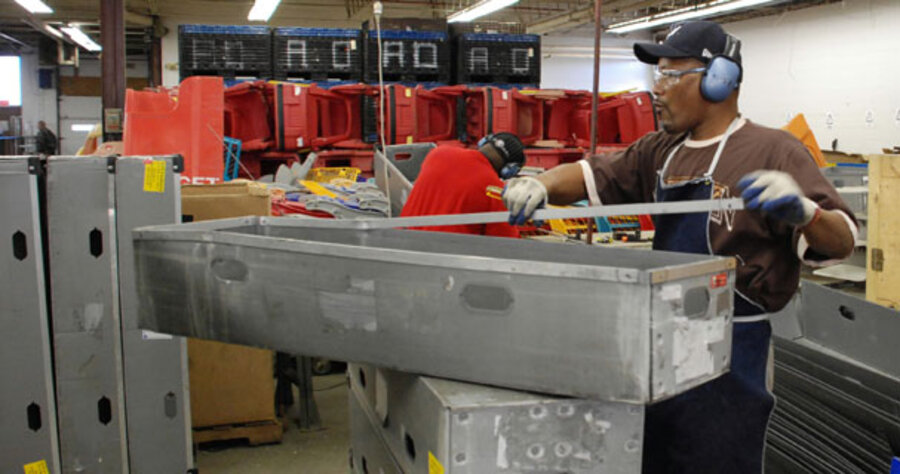General Motors in hot pursuit of 'landfill-free' facilities
Loading...
| Flint and Lake Orion, Mich.
While even the greenest cars on the market today emit clouds of carbon dixoide, General Motors engineers are out to prove that making cars doesn't have to be a dirty business.
American auto giant aims to convert half of its 181 facilities worldwide into "zero waste" operations by 2010. That means not a scrap of metal from those GM sites, or even a juice box from a worker's lunch pail, would end up in a landfill.
Sound impossibly ambitious? Consider that last month the company announced its ninth and 10th landfill-free plants. Several more have also reached the goal, say GM officials, but those announcements haven't been made yet.
The effort puts GM alongside a small but growing number of organizations to adopt a zero-waste agenda. Wal-Mart and even 70 percent of New Zealand's municipalities are working to eliminate all trash. Unlike environmental efforts that drag big business along kicking and screaming, the cost savings associated with zero-waste programs have given companies incentive to be at the forefront of the movement.
"Businesses are the ones that are leading the way and showing that it's ... not a crazy idea," says Gary Liss, a zero-waste consultant based in Loomis, Calif.
That's because adopting the zero-waste model offers many businesses quick returns on their investments – unlike switching to some other earth-friendly initiatives, such as solar power. Indeed, more than any initial financial cost, businesses need to invest "the time and effort to get over the hurdles to figure out what needs to be changed," says Mr. Liss.
As for GM, waste disposal was cheap for most of the firm's 100-year history.
"The focus in the past had been that the waste is part of the business," says Raymond Tessier, group director of environmental services for GM's worldwide facilities group.
But about 10 years ago, tighter restrictions on waste disposal – and the subsequent rising costs – began to challenge that mentality. "We started to look at it as, 'No, this is a resource, and if we can't use that resource in our manufacturing process then that's costing us money,' " says Mr. Tessier.
Since then, GM has sought ways to redesign its systems to cut waste – and it has the savings to show for it. Between 2002 and 2006, GM North America reported, it reduced total waste by 25 percent and saved 39 percent on waste-management expenses.
Moreover, factory conversions have cost GM little. It costs $20,000, an insignificant amount for the auto giant, to attain landfill-free status for a factory that has already slashed waste by 90 percent, which is 1 out 3 of GM plants worldwide, says Tessier. In some cases, the savings cover the costs of attaining zero-waste status, in effect costing GM nothing.
In the city of San Francisco, which has committed to being landfill-free by 2020, "we discuss waste as a design flaw," says Jared Blumenfeld of the city's Department of the Environment. "Ultimately, if something is designed correctly, whatever it is, there shouldn't be any waste." Residents and businesses there currently recycle or reuse 69 percent of all garbage.
"There's no CEO in the nation who would ... say, 'Oh, we think that waste is a good thing.' Waste is just eating into their profit margin and reducing their efficiency," says Mr. Blumenfeld. "So getting to zero waste, from a corporate perspective, makes a lot of sense."
Take GM's Tool and Die Plant in Flint, Mich., the latest facility GM has declared to be landfill-free. It makes polystyrene, or Styrofoam, patterns that are used to create cast-iron dies that stamp out body parts for new vehicles. Consequently, the plant generated huge amounts of polystyrene waste.
"We had a semi going back and forth all day long taking scrap to the landfill," recounts John Lanser, a senior worker at the plant. "We knew that the expense of the landfill had to be sky-high and … that it won't take long before we're going to need another landfill because this stuff doesn't break down at all."
The drive to recycle came from workers, with no prompting from headquarters. Mr. Lanser's supervisor found a way to return the scrap to the supplier for reuse, and this year the Flint plant will recycle enough polystyrene to make 42 million coffee cups. The cost of landfilling all the material had been so great that recycling it actually cut plant operating costs.
It will take time, however, for all GM plants to be landfill-free. So far, most plants doing away with trash have been nonassembly plants. Facilities that produce cars create the most difficult waste to recycle or reuse: paint sludge.
"When you paint a vehicle, not all the paint actually adheres itself to the car.... The extra paint is captured in a water system and there's a sludge that's generated," says Michael Schafran, senior environmental engineer at GM's Orion Assembly Plant in Lake Orion, Mich. "We have not yet found a home for [the paint sludge] on the recycling side."
GM is looking into ways to use the sludge in a waste-to-energy program that would burn it to make electricity.
The US Environmental Protection Agency does not certify or advocate zero-waste programs. However, it has "found that many of our stakeholders are finding that ... the basic concepts ... of zero waste work for them," says Thea McManus of EPA's municipal and industrial solid waste division.





